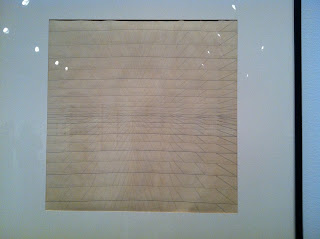 |
| Mira Schor's exhibition, Death is a Conceptual Artist, at Lyles and King, which closed last week. Gallery Link |
 |
| The works revealed the many directions that shape an identity, a life. |
 |
| They are fast and immediate, made with ink, conte and charcoal drawings on large, primed sheets of Japanese paper |
 |
| Imbuing alter egos with presence |
 |
| A 1976 Barcley L. Hendricks in the Whitney Museum's Human Interest exhibition Exhibition Link Holland Cotter's NYT Review |
 |
| Larry Rivers' painting of Birdie, a stalwart reminder of a glorious past, with buoyant spring color and flower patterns. |
 |
| Detail. I have always loved this painting. |
 |
| Will add artist's name for this beautiful work, which strikes me for its structure, color, hand. |
 |
| Lush portrait of Gertrude Vanderbilt Whitney - such an unusual plum color with the dazzling greens, that gorgeous blank sofa! |
 |
| Fairfield Porter detail - the paint is thick, Expressionistic, but the images so fleeting, yet pared down, like ancient sculpture. |
 |
| Rauschenberg, a simply gorgeous example, and small! I think of works from him from this period in much larger scale. |
 |
| Will add artist's name for this '70s masterpiece, which looks so good now |
 |
| Detail |
 |
| Detail |
 |
| Richard Bechtle, central panel of a triptych that feels new again, and is sumptuously painted--meticulous, but a little smeary to soften everything and reflect the diffuse, Bay Area light. |
 |
| The car - look at that fender - so beautiful |
 |
| Henry Taylor - thick, worked paint |
 |
| Alex Katz - thin, breezily applied paint |
 |
| Julian Schnabel, an energetic early work |
 |
| Robert Mapplethorpe - I'd never seen this |
 |
| Near Warhol's Jackie, showing the change that can happen in a life - so real to us now |
 |
| Jackie and Caroline, do not remember the artist here either, but surprisingly relevant now |
 |
| Downstairs at the Whitney, ground floor--a lovely exhibition by June Leaf |
 |
| She has such a distinctive hand |
 |
| Large bird looming, a personal favorite - sketchy, but has everything |
 |
| Leaf's work was presented in groupings such as this |
 |
| There was a casual, sketchbook feel - similar to Schor in the immediacy and directness of images |
 |
| Yet like Schor's they are well-developed, not lacking in necessary detail. |
 |
| Versions of psychological portraiture... |
 |
| I've always loved the grit in her work, the logic that springs from studio to world, uncompromising |
 |
| The artist |
 |
| A work on an easel near wall works that repeat the image many times again |
 |
| Sculptural works on a table in the center of the room; she has made these always |
 |
| The sculptural works feel of a piece with the wall works as thought realized in multiple forms. |
 |
| Kerry James Marshall in Unfinished at Met Breuer Unfinished: Thoughts Left Visible Link |
 |
| A lovely Picasso, surreal to see in the old Whitney building. So good to view art there again. |
 |
| The great Titian - a Tarquin and Lucretia - amidst the palimpsest of so many Biennials. How lovingly structured and sensitively handled Titian's paintings are! |
 |
| Titian's Flaying of Marsyas, one of the greatest paintings of all time, co-existing with so many different works. The mashup of time periods and locations is a wonderful way to see art. |
 |
| Detail, Titian's Flaying of Marisa |
 |
| Downstairs, Nasreen Mohamedi's lovely drawings. Mohamedi Link |
 |
| Subtle, delicate, taking you so many places. |
 |
| Inspiring. |







